The Ultimate Guide to Storing Frozen Pie Crusts in Your Refrigerator
Pie crusts are the unsung heroes of the baking world. Whether you’re crafting a delicious apple pie for a holiday feast or preparing a savory quiche for a cozy brunch, a good pie crust is essential. But what happens when you find yourself with leftover frozen pie crusts, or perhaps you bought some on sale and want to store them for future use? Understanding how long a frozen pie crust lasts in the refrigerator is crucial to ensuring your culinary endeavors don’t fall flat.
In this comprehensive guide, we’ll explore all about storing frozen pie crusts, their shelf life in the refrigerator, and share practical tips to maximize their freshness.
🥧 Why Store Frozen Pie Crusts?
Convenience is the main reason why many home cooks and bakers opt for frozen pie crusts. They save time, require no special skills to prepare, and are versatile for various recipes. These crusts often come pre-rolled and ready to use, providing a kitchen shortcut without sacrificing quality.
Yet, understanding the best storage practices becomes essential if you can't use these crusts immediately. Proper storage not only maintains their quality but also ensures food safety.
🏷 Understanding the Shelf Life of Frozen Pie Crusts
How Long Can They Really Last?
When it comes to frozen pie crusts, keeping them in the freezer is ideal for long-term storage. In a freezer setting, frozen pie crusts can last up to a year without significant quality deterioration.
However, the dynamics change drastically when these frozen crusts are moved to a refrigerator. Once placed in the fridge, they might last a few days to a week at most. The key factor here is to recognize any signs of spoilage before they become unfit for consumption.
Indicators of Freshness or Spoilage
When storing frozen pie crusts in the refrigerator, be on the lookout for these signs:
- Texture Changes: A soggy or excessively dry texture can indicate spoilage.
- Off Odors: Unpleasant smells are a strong indication that the pie crust may not be safe to use.
- Discoloration: Any visible mold or discoloration on the crust is a red flag.
Remember: Always trust your senses. If anything seems off, it’s better to err on the side of caution.
📦 Proper Storage Techniques
Keeping Frozen Pie Crust Safe in the Refrigerator
To maximize the shelf life of your pie crusts in the fridge, adhere to these storage practices:
Keep It Sealed: Store the pie crust in its original packaging or wrap it tightly with plastic wrap or aluminum foil to prevent exposure to air and moisture.
Choose the Right Spot: Place the pie crust in the coldest part of the fridge, typically the back, to maintain a consistent temperature.
Label with Date: As a handy reference, always label the crust with the date it was transferred from the freezer to the fridge.
By following these practices, you can help ensure your pie crust maintains quality and remains safe for consumption.
🏷 Transitioning from Freezer to Fridge: Best Practices
Thawing Tips for Optimal Results
When moving a pie crust from the freezer to the fridge, you might need it ready for immediate use. Here’s a quick guide:
Gradual Thawing: The best way to defrost is to move it to the refrigerator a day before you plan to bake. This gradual thaw ensures even consistency.
Avoid Quick Thawing: Steer clear of thawing on the countertop as varying temperatures can alter texture and potentially promote bacterial growth.
Baking from Frozen: If you're in a rush, some pie crusts can be used directly from the freezer. Just be sure to adjust baking times according to package instructions.
Additional Considerations
While some may be tempted to refreeze after thawing, repeated freezing and thawing cycles can degrade quality. It’s advisable to plan accordingly to prevent unnecessary waste.
🥧 Incorporating Pie Crusts into Various Recipes
More Than Just Desserts!
Frozen pie crusts are not just for traditional sweet pies. Their versatility extends to:
- Quiches: A savory delight perfect for breakfast, lunch, or dinner.
- Tarts: Both sweet and savory options allow for creativity in the kitchen.
- Pot Pies: Perfect for utilizing leftovers in a hearty way.
Each of these recipes benefits from the convenience and quality of a well-preserved pie crust.
🔎 Quick Reference Guide: Key Takeaways
Here’s a handy summary to help you manage your frozen pie crusts efficiently:
- ❄️ Freezer Storage: Ideally one year for optimal quality.
- 🕒 Refrigerator Storage: Best used within a few days to a week.
- 🚫 Spoilage Signs: Check for texture changes, off odors, and discoloration.
- 🔒 Proper Wrapping: Keeps crust fresh by locking out air and moisture.
- 📆 Labeling: Helps track storage duration easily.
- 🥘 Recipe Versatility: Suitable for both sweet and savory dishes.
By keeping these tips in mind, you can make the most of your frozen pie crusts, ensuring delicious results every time you bake.
Pie making has never been easier, thanks to the convenience of frozen crusts. Understanding their storage nuances enables you to enjoy various delicious baked goods without hassle or worry. By following these guidelines, you’re well-equipped to store and use your pie crusts wisely while maintaining their quality and safety.
So, the next time you grab a frozen pie crust, you can rest assured knowing exactly how to store it in your refrigerator for best results. Now, time to get baking!
